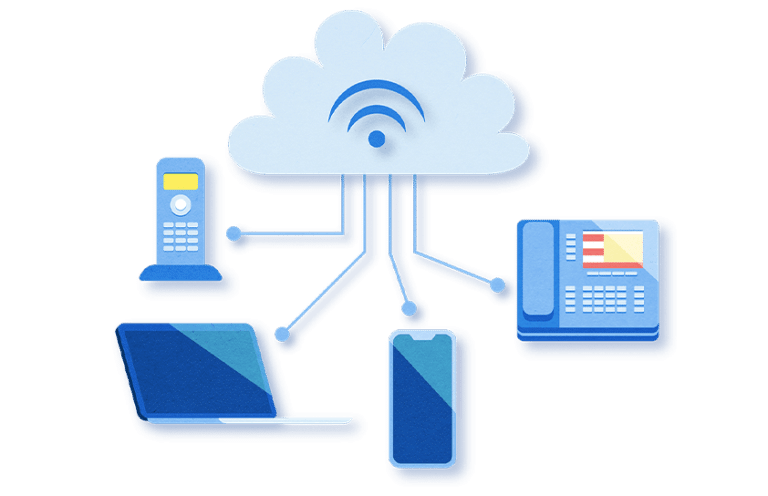Mastering Call Handling Skills: A Guide for Small Businesses
Mastering call-handling abilities is a game-changer for a small business. It directly impacts customer experience, building a lasting relationship with your customers and maintaining a professional image. A positive first impression over the phone can be the deciding factor between gaining or losing a client.
Studies show that 54% of customers prefer to resolve their queries and issues over the phone rather than through other channels like email or chat. Therefore, it is essential to ensure that your call handler delivers good call-handling practices that align with your customers’ needs.
Source: Statista
A comprehensive live-answering service like PATLive can significantly boost customer satisfaction by providing real-time responses, addressing customer inquiries, reducing wait times, and ensuring that all customer calls are handled professionally.
These services help manage high call volumes while offering efficient solutions like call routing, call transfers, and customer relationship management (CRM) integrations that can make this process seamless. With experts like PATLive, you can focus on growing your operations without being bogged down by missed calls or unsatisfied clients.
In this article, we’ll review effective call-handling techniques that are required to maintain customer retention and brand loyalty and explore how some call-handling best practices can be implemented to optimize your live answering operations and improve the bottom line of your business.
The Art of Active Listening
Active listening is a crucial skill in call handling that directly impacts customer satisfaction. It goes beyond simply hearing words—it’s about fully understanding and responding to the needs of the person on the other end of the line. Mastering this skill can lead to stronger customer interactions and improved customer experience.
Techniques to Practice Active Listening
There are several practical techniques that can elevate your call-handling skills when it comes to active listening:
- Paraphrasing: Restate the customer’s issue in your own words to confirm your understanding. This helps avoid misunderstanding while showing your attentiveness to your caller, making them feel heard and valued.
- Summarizing: Provide a concise recap of the conversation to ensure all customer needs are covered before concluding the call.
- Ask Clarifying Questions: This allows you to probe deeper into customer issues, ensuring no details are missed and, sometimes, even helping the caller get a deeper understanding of the context while showcasing your expertise.
Demonstrating Empathy and Understanding
Empathy is a key to creating a positive customer experience. When your call handlers acknowledge a customer’s frustration or concerns, it builds trust and demonstrates that their feelings are being taken seriously. This approach can be particularly helpful during escalation scenarios, where a calm, empathetic response can help de-escalate tension and improve outcomes.
According to a Microsoft report on State of Global Customer Service, nearly 96% of customers say customer service is essential to brand loyalty. Thus, active listening makes the customer feel valued and leads to better first-call resolution, reducing call volume and improving agent performance.
Effective Communication Techniques
Clear and effective communication is the foundation of good call handling. Whether you’re managing routine customer calls or dealing with complex customer issues, the way you communicate can directly influence the outcome of the conversation.
Let’s take a look at some key techniques to enhance communication and ensure a positive customer experience.
Keep It Clear and Direct
Clear and concise communication is critical for successful call handling. When your call handler speaks in a straightforward manner, it prevents confusion and ensures that customer inquiries are addressed promptly. Without precise communication, you can lose valuable time and face frustrated customers. To avoid this, keep your responses short and focused on resolving the issue at hand.
Tone That Builds Trust
The tone of voice can make or break a conversation. Using a positive and friendly tone fosters a better customer experience and builds rapport during customer interactions. Whether handling an inbound call for a sales inquiry or an outbound for a follow-up, always strive to make the customer feel comfortable and valued.
Smiling while you talk, even if the customer can’t see it, can improve how your tone is perceived on the other end of the line.
Your Posture Speaks Volumes
Though it may seem less important over the phone, body language affects how clearly and confidently you communicate. Standing or sitting up straight can help your voice sound stronger, boosting your live receptionist’s confidence during phone calls.
Nonverbal cues, even if not visible to the customer, help maintain focus and create a sense of professionalism.
The Communication Advantage
Mastering effective call handling requires a blend of communication skills that go beyond words. Soft skills like tone of voice, body language, and attentiveness can significantly impact performance and customer satisfaction.
By practicing these techniques, you can reduce wait times and improve first-call resolution, ultimately leading to a positive brand image.
Handling Difficult Calls with Grace
Sometimes, difficult calls are just inevitable, but how you handle them can make all the difference. Let’s explore some key techniques to help you manage such situations effectively.
Stay Calm, Stay Composed
Handling difficult customer calls can be a challenge, but staying calm is the key to navigating these situations successfully. When your call-handling live receptionist remains composed, it can help de-escalate tensions and encourage the customer to mirror that calm energy. Maintaining a steady, professional demeanor is crucial, especially when the customer is frustrated.
De-escalate Strategically
Difficult calls often involve heightened emotions, but you can turn the conversation around with the right de-escalation techniques. Techniques like acknowledging the customer’s feelings, actively listening, and using calm phrases such as “I understand how you feel” can help diffuse frustration.
Provide Solutions, Not Excuses
When your callers are upset, offering actionable solutions and alternatives is the best way to resolve their concerns. Rather than finding excuses, focus on finding ways to meet the customer’s needs with practical options. Offer multiple solutions to allow the customer to choose what they prefer the most. Offering alternatives shows how proactive and invested you are in resolving their issues.
For example, if a product is out of stock, offering a similar alternative or expedited shipping on the back-ordered item could turn a negative experience into a positive one. In doing so, you foster trust and improve the customer experience.
According to research, 70% of customers will continue doing business with a company if their complaint is resolved successfully. Offering solutions promptly can help your call handlers navigate even the most challenging calls gracefully while retaining customers for the long term.
Building Rapport with Callers
Establishing a personal connection while handling calls can turn a simple customer call into a positive experience that leaves a lasting impression. Building rapport with callers can help build trust, increase customer satisfaction, and encourage loyalty.
Here are some key ways to establish that connection during customer interactions.
Make it Professionally Personal
One of the simplest yet most effective ways to make a caller feel valued is by using their name throughout the conversation. Addressing the customer by name creates a sense of familiarity and personal attention, making them feel more than just another caller with an inquiry. It’s a small gesture, but it helps establish a connection and demonstrates that you’re engaged in the conversation.
Show You Truly Care
To build trust with callers, showing a genuine interest in their concerns and needs is essential. Listening carefully to their issues and asking thoughtful follow-up questions demonstrates that you’re fully invested in helping them. This not only enhances the customer experience but it also strengthens the relationship between the customer and the brand.
According to a Salesforce study, 84% of customers say that personal treatment is more crucial to winning their business than being treated like a number. Going beyond scripted responses and engaging with genuine curiosity leaves a lasting impact on the customer experience.
Source: Salesforce
Build Trust Through Personal Touch
Taking the time to understand and respond to each caller’s individual needs is crucial for building rapport. Simple actions such as asking open-ended questions and expressing empathy can make a significant difference. A customer who feels listened to and understood is more likely to stay loyal and view your business positively, resulting in a better brand image.
While going beyond a script and truly understanding each caller’s individual needs can be time-consuming and require significant resources, it’s essential for delivering top-notch service.
That’s where PATLive comes in. With our team of highly trained, professional virtual receptionists, we ensure that every customer receives personalized care and attention. You can continue to maintain high standards to meet your customer expectations while allowing you to focus on your business.
The Importance of Professional Etiquette
Professional etiquette plays a vital role in ensuring every customer interaction is positive and leaves a lasting impression. Whether handling customer inquiries or reaching out for feedback, how you greet, communicate, and close the conversation sets the tone of the entire customer experience.
Politeness Goes a Long Way
First impressions matter, beginning with a polite and respectful greeting. Whether you’re dealing with a routine customer call or a more complex customer issue, starting the conversation with a warm, respectful tone builds immediate trust.
Greeting callers with a friendly “Hello, thank you for calling!” or a personalized “Good morning, [caller’s name], how can I assist you today?” sets a welcoming atmosphere from the very start.
Keep It Simple
When speaking with customers, especially those who may not be familiar with industry-specific terms, it’s important to avoid jargon or technical language. Overcomplicating the conversation can confuse customers and create barriers.
Instead, use clear and simple language to explain your company’s products or services. This makes the conversation more accessible and ensures that your customers fully understand what’s being communicated.
Gratitude is the Key
Ending the call with a sincere thank you can leave a positive impression and improve customer satisfaction. Whether it’s thanking them for their time, and patience, or feedback based on the nature of the call, expressing gratitude shows that you value their business and care about their experience.
A simple phrase like “Thank you for your time; we appreciate your business and look forward to serving you again” can go a long way toward building a lasting relationship.
Call Handling Best Practices
To master call handling, following a set of best practices that ensure consistency and quality assurance across all customer interactions is essential. Whether you’re managing routine customer calls or navigating more complex issues, these practices can help you provide top-notch service while enhancing customer satisfaction.
Expect Common Questions
Anticipating common questions and concerns is key to providing efficient call handling. Whether it’s about your company’s products, pricing, or shipping details, being prepared with quick, clear answers keeps the conversation smooth and personal. It’s also important to stay updated on your business’s offerings to avoid delayed responses to queries.
Take Notes and Follow Up
Taking accurate notes during a call is vital for ensuring that no details are missed. This practice helps in quick problem-solving and allows for scheduling a call back to follow up on any promises made during the conversation.
Whether it’s sending an email or providing additional information, keeping track of customer needs and following up as promised is essential for building trust and improving brand image.
Efficient Call Transfers and Forwarding
Call handling processes require efficient call transfers and forwarding. When a call handler needs to transfer a customer to another department or representative, seamlessly doing so shows professionalism and respect for the customer’s time.
According to a report by Zendesk, 72% of customers attribute poor customer experience to having to explain their issue to multiple people during a single interaction. Thus, providing context during the transfer and ensuring that the customer doesn’t need to repeat their issue improves overall customer satisfaction.
Source: Zendesk
Upgrade Your Business with Live Answering
If you own a small business, mastering call handling is crucial to delivering a seamless customer experience and ensuring long-term success. Effective call-handling skills help build trust, improve customer satisfaction, and streamline business operations by reducing wait times and resolving customer issues efficiently.
PATLive provides professional live answering and web chat services that can take your customer service to the next level. With well-trained professionals handling your customer calls and responding to customer inquiries via web chats, you can ensure that every interaction is handled with care, providing the personalized support your customers deserve.
Our team of experts can efficiently handle calls and also enhance your web presence by managing chats in real-time with your customers, further boosting your ability to engage and satisfy your customers.
With PATlive, you can focus on your core business while we manage your calls and web chat support. Reduce missed calls, provide instant responses via web chat, and stay ahead of your competition.
Elevate your customer service today and learn how our comprehensive and live answering services can improve your business operations to enhance the customer experience.







